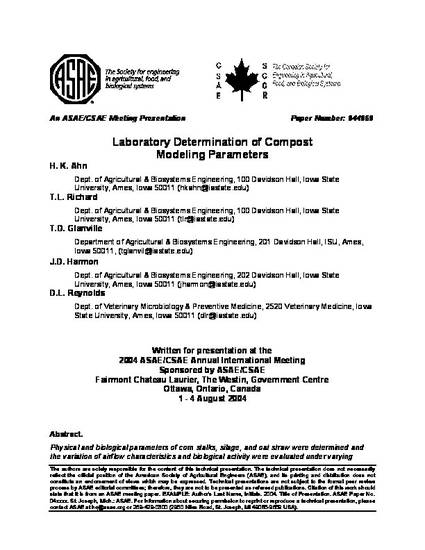
Physical and biological parameters of corn stalks, silage, and oat straw were determined and the variation of airflow characteristics and biological activity were evaluated under varying moisture contents. The predicted air-filled porosity showed high correlation with measured airfilled porosity over the all materials. A reliable model of air-filled porosity made it possible to predict the effect of varying moisture content and compost bed height on air-filled porosity and permeability. The air-filled porosity decreased with increasing moisture content and compost depth for all materials. Corn stalks and oat straw air-filled porosity was in the range of 69-97% over the all moisture levels and bed heights tested. Silage showed a wider range of air filled porosity than the other two materials, varying from 43 to 89%. The effective particle size of all three materials increased with increasing moisture content from 20% to 80%of WHC. Permeability increased with increasing air filled porosity and decreasing bulk density, but the relationship between permeability and moisture content is complex. Permeability decreased for all materials with increasing moisture content from 20% WHC to 50% WHC, regardless of the depth of the compost bed. Since the particle size increased dramatically near saturation, the influence of aggregated particle size on the permeability is not significant at these relatively low moisture levels. But the permeability increased with increasing moisture level from 50% to 80% WHC at moderate to shallow simulated bed depths (Corn stalks: 2.1 m, Oat straw: 1.5m, Silage: 0.8 m). This results from the relatively large particle size aggregations under high moisture conditions, which compensate for the effect of reduced air filled porosity by compaction and moisture content at moderate to shallow bed depths. In this study the maximum wet bulk density and mechanical strength decreased with increasing the moisture content. The optimum moisture contents for respiration rate of corn stalks, oat straw, and silage are 81%, 64%, and 78% respectively. The method described for determining physical and biological properties under varying moisture content and compost bed depths will be very useful for designing and modeling composting process with a variety of materials.
Available at: http://works.bepress.com/thomas_glanville/23/

The publication of this document has been funded in part by the Iowa Department of Natural Resources through a grant from the U.S. Environmental Protection Agency under the Federal Nonpoint Source Management Program (Secton 319 of the Clean Water Act).
This is an ASAE Meeting Presentation, Paper No. 044060.